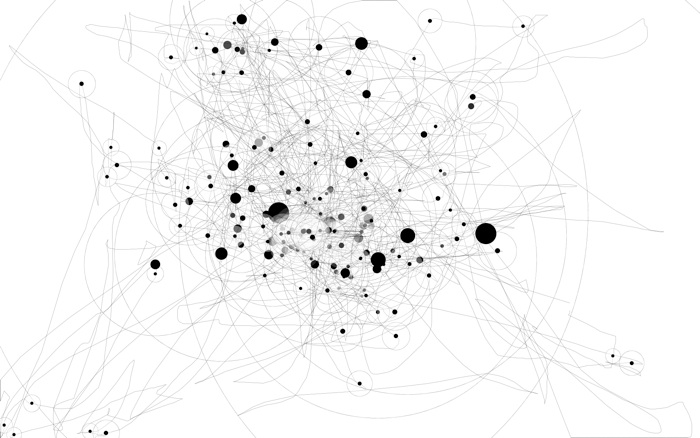I discovered a neat bit of software last week. It’s called IOGraph and you can download it here for Windows, OSX or Linux. If you leave it running in the background, it will trace your mouse movements. It will also put a ‘blob’ where your mouse movement comes to a stop. The bigger the dot, the more time the mouse has been left in that position.
Although the intention for it was to be an artistic application, I had a slightly more scientific idea for it…
Windows vs OS X
I decided to do a little experiment. I ran IOGraph whilst using Windows XP, and whilst using Mac OS X (Snow Leopard) for around 20 mins each. I was using the same display (my 24” iMac screen), so the screen area had no bearing on the outcome. I stuck to ‘general’ usage – staying predominantly in my web browser, but also exploring the filesystem and launching documents/applications.
Here is the Windows XP graph:

Of course, since I keep Firefox running windowed (a 24” browser window isn’t really necessary!) and roughly in the middle of my screen, this is where most of the mouse activity is. Also interesting to note is the activity to the bottom left of my screen. This is due to the start menu in the corner and the quick-launch icons I keep to the left of my taskbar.
The blobs near the top of the screen indicate where I have visited the menu bar of a particular application window. There seem to be more on the left, which makes sense, since this is where the common ‘File’, ‘Edit’ etc. commands are placed.
Let’s have a look at the OS X graph:

The first thing that you notice is that it is less busy towards the middle of the screen. You can ignore this for the most part, because it was likely due to the content of the individual websites that I visited being different in each case. However, the distribution does seem to be less concentrated in this graph.
This time, you will notice a lot of mouse movement to the bottom of the screen. This is because I rely on the dock for most of my navigation on my Mac. The most common applications are to the bottom left. I also keep folders in the bottom right of my dock. This explains the trails in those areas.
There is some activity to the top right of the screen, as this is where OS X’s Spotlight search function is located.
Conclusions
I attempted this mini-experiment with the hypothesis that it would highlight quite significantly the differences between the interfaces of the two operating systems. However, I was slightly surprised to see that the difference wasn’t as dramatic as I expected. One thing that may have helped the accuracy of the graphs is if a blob was recorded as a result of a click, rather than just a stopping point for your mouse.

The graph above is one taken from using OS X over a period of 1.7 hours. This longer time period highlights usage of the dock a little more clearly. Maybe a couple of hours usage on each OS would have given clearer results. However, I doubt they would have been different.
The most significant conclusion I can make from this is that my computing experience is largely centred around my web browser. And I am fairly sure this is an increasingly common trend. Whereas over 10 years ago, the internet browser was just another application to be used only when required, now the browser is integral to the whole concept of ‘using a computer’.
Since I use similarly configured Firefox browsers on both OS X and XP, this means that my mouse activity will largely be the same on either operating system for the core portion of my computing. I keep RSS feeds on my bookmarks toolbar at the top of the window – which explains a lot of those upper blobs common to both graphs. I manage tabs in this part of the browser window too.
This raises an important thought to take away. Web browsers are taking up an increasing proportion of our total computer usage time. With the concept of ‘cloud computing’ being explored to a greater extent in the near future (where programs are browser based rather than being a separate application stored on your hard drive), this trend is set to continue.
Does this mean user interface differences between operating systems is becoming less relevant? I’d hazard a yes. It might even point to the web browser becoming completely integrated with the operating system. Your desktop could become just a big browser window!

